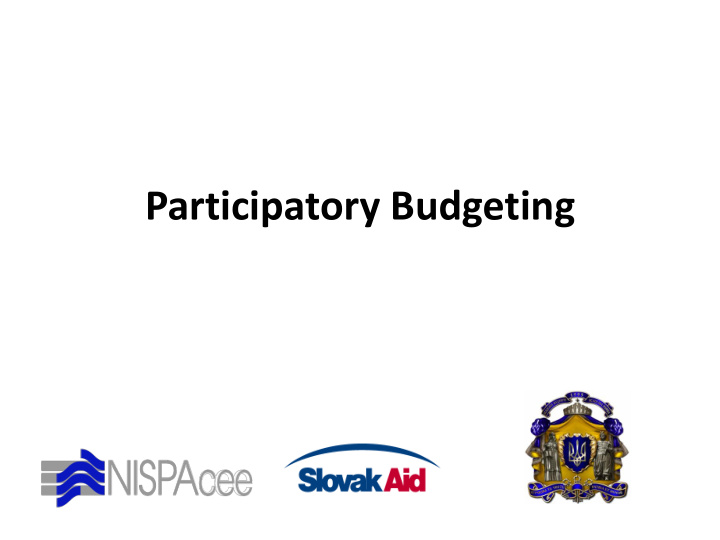



Participatory Budgeting
Purpose of the module • To provide relevant knowledge – Participatory budgeting • To train skills – Elaboration of plan for implementation of participatory budgeting
Expectations • Understanding background of participatory budgeting • Being aware of pros ´ and cons ´ of participatory budgeting • Orientation in the present relevant Ukrainian and international experience • Readiness to propose relevant tools for implementation of participatory budgeting
Foundations of PartB
Porto Alegre and the others • Formal structuring (legislation) • Administrative structuring • Time cycle definition • Dynamic incentive to direct participation • Dynamic establishment of PB council • Financial resources • Technical analysis of approved ventures • Establishment of monitoring instances
Principles of PartB (Smith 2009) I • Inclusiveness – Equal possibility for access • Popular control – Full awareness and openess • Considered judgement – Maturity of decision makers (citizens)
Principles of PartB (Smith 2009) II • Transparency – Contribution of general awareness of public affairs • Efficiency – Quantity vs. quality (how and what to assess?) • Transferability – Only transferable public tasks or public tasks which might be replaced/substituted
Diversity of PartB models Krenjova and Raudla 2013: 23
European models Krejnova and Raudla 2013
Lisbon case Source of Lisbon study: based on research done together with E. Vešicová for her Master thesis
Lisbon experience
European experience I • Conflicting results – Not only between the countries but also within the countries and even within the cities • Strong dependency on – social „ atmosphere “ in the city – political will – bureacratic readiness – availability of leadership
European experience II • Selectivity – Participation – Projects • Innovative measure with questionable impact – Engagement and inclusiveness vs. opportunism – Extremists as highly disciplined groups
Sensitive issue VOX POPULI, VOX DEI!
Crucial point • To be aware of possible risks/threats • To be ready to prevent them • To be ready to react if they occur
Risk and threat matrix Risk / Threat Occurance Importance Total score probability Low participation 3 4 12 Insufficient number of applications 2 5 10 ... • Occurance probability (1 very low – 5 very likely) • Importance (1 insignificant – 5 very important) • Total score: everything what is over 10 should be accompanied by explanation how to prevent/avoid the risk/threat (prevention) and what to do if the risk/threat occurs (intervention)
Insufficient number of applications • Prevention: – Local government has a sufficient dissemination plan – Local government is familiar with the community leaders, and a plan how to train them – Local government disposes with a project-store • Intervention: – Postponement of deadline for submission of applications – Activation of applications from a project-store
Case study 1 (Bratislava) Source of case study: based on research done together with E. Vešicová for her Master thesis
Case study 1 (Bratislava) • Introduction of pilot project: 2011 • 5 areas: – Green city – Culture – Transport in the city – Seniors – Youth • City of Bratislava + NGO Utopia
Case study 1 (Bratislava) • 01/02: public assembling (information on approved projects) • 03: reporting on PartB from previous year • 03-06: regular meetings of participating communities • 04: public forums of participating communities • 05-06: consultations with the city and public debate
Case study 1 (Bratislava) • 09-11: regular meetings of participating communities • 09: eVoting • 10: end of eVoting and decision or resource • 11: public presentation of approved projects and implementation of previous projects • 12: negotiation of local council and final approval of participatory budget
Case study 1 (Bratislava) • 2012: 30,000 EUR (0,014%) • 2013: 46,000 EUR (0,020%) • 2014: 46,000 EUR (0,019%) • Future: ??? – Low interest at the side of the city – Relatively low participation (annually ca 260 active citizens)
Case study 2 (Ružomberok) Source of case study: based on research done together with E. Vešicová for her Master thesis
Case study 2 (Ružomberok) • Consultations among the citizens and public debate • Consultations with the city representatives • Approvals/disapprovals of presented ideas by specialized committees • Elaboration of projects • Approvals/disapprovals of the projects by the local council • eVoting
Case study 2 (Ružomberok) • High level of engagement and volunteering • Not only citizens but also local entrepreneurs (provision of free material) • Multi-source approach: public resources + private resources (in-kind/financial/donations)
Case study 2 (Ružomberok) • 2012: information • 2013: 5,000 EUR (0,03%) • 2014: 15,000 EUR (0,08%) • Future: continuation – Support from the city and its representatives – Higher participation than in Bratislava: 340 – 460 citizens
Discussion • What are the main pros ´ to introduce the PartB? • What are the main risks/threats which are linked to introduction of the PartB in your city? • Would you introduce the PartB also in small cities and villages?
Recommend
More recommend